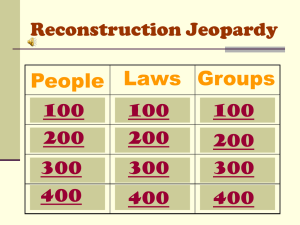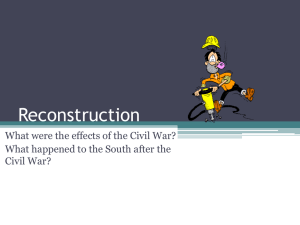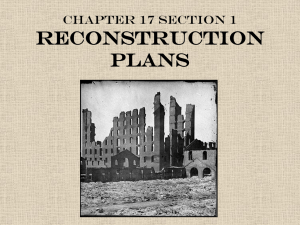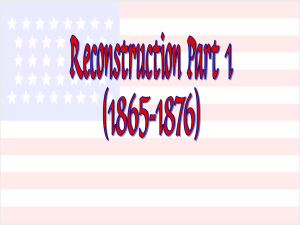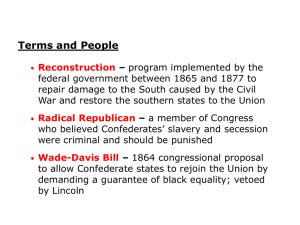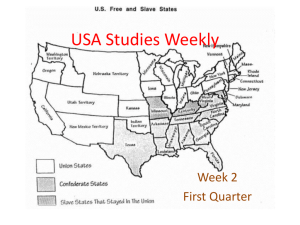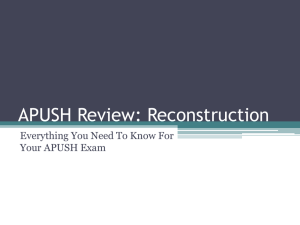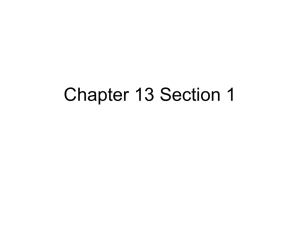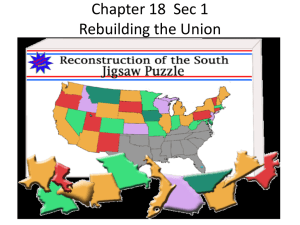Lincoln`s Second Inaugural Address
advertisement
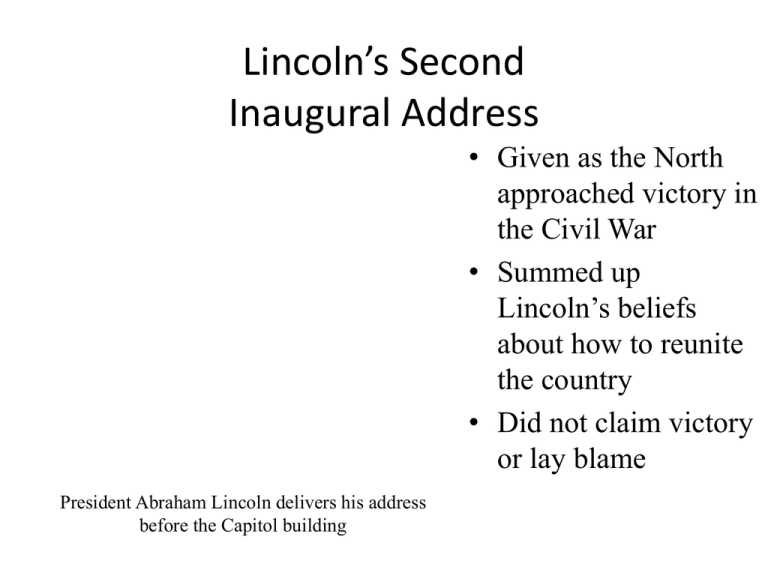
Lincoln’s Second Inaugural Address • Given as the North approached victory in the Civil War • Summed up Lincoln’s beliefs about how to reunite the country • Did not claim victory or lay blame President Abraham Lincoln delivers his address before the Capitol building From Lincoln’s Second Inaugural On the occasion corresponding to this four years ago all thoughts were anxiously directed to an impending civil war. All dreaded it, all sought to avert it. While the inaugural address was being delivered from this place, devoted altogether to saving the Union without war, urgent agents were in the city seeking to destroy it without war—seeking to dissolve the Union and divide effects by negotiation. Both parties deprecated war, but one of them would make war rather than let the nation survive, and the other would accept war rather than let it perish, and the war came… With malice toward none, with charity for all, with firmness in the right as God gives us to see the right, let us strive on to finish the work we are in, to bind up the nation’s wounds, to care for him who shall have borne the battle and for his widow and his orphan, to do all which may achieve and cherish a just and lasting peace among ourselves and with all nations. Lincoln’s Final Public Speech • At the White House on April 11, 1865 • Lincoln suggested that some blacks be given the right to vote • John Wilkes Booth was present • Booth shot Lincoln three days later A later photograph of Abraham Lincoln From Lincoln’s Final Speech It is also unsatisfactory to some that the elective franchise is not given to the colored man. I would myself prefer that it were now conferred on the very intelligent, and on those who serve our cause as soldiers. Some twelve thousand voters in the heretofore slave-state of Louisiana have sworn allegiance to the Union, assumed to be the rightful political power of the State, held elections, organized a State government, adopted a free-state constitution, giving the benefit of public schools equally to black and white, and empowering the Legislature to confer the elective franchise upon the colored man. Their Legislature has already voted to ratify the constitutional amendment recently passed by Congress, abolishing slavery throughout the nation… We encourage the hearts, and nerve the arms of the twelve thousand to adhere to their work, and argue for it, and proselyte for it, and fight for it, and feed it, and grow it, and ripen it to a complete success. The colored man too, in seeing all united for him, is inspired with vigilance, and energy, and daring, to the same end. Grant that he desires the elective franchise, will he not attain it sooner by saving the already advanced steps toward it, than by running backward over them? Lincoln’s Assassination • April 14, 1865, in Washington, DC • Assassin John Wilkes Booth • Other government officials targeted by conspiracy • Many believe Lincoln’s death led to harsher terms for the South Lincoln’s preserved box in Ford’s Theater, including the flag bunting Booth pulled down as he leapt to the stage Discussion Questions 1. What themes did Lincoln touch on in his Second Inaugural Address? How did the time at which he delivered it affect its message? 2. What about Lincoln’s April 11th speech motivated John Wilkes Booth to assassinate him? Why might this have angered Booth? Lincoln’s “Ten-Percent Plan” • Released in December 1863 • “Executive Reconstruction” • Would pardon most former Confederates • When 10% of the number of voters in 1860 signed loyalty oaths, the state could form a new government • Used to return areas such as Louisiana back to the Union “Radical Republicans” Rep. Thaddeus Stevens • Faction from 1854 to end of Reconstruction • Wanted tougher policies for former Confederate states • Believed in equal rights for freed slaves, other blacks • Led bySen. Sen. Sumner Charles Sumner and Rep. Stevens The Wade-Davis Bill • Passed Congress in 1864 • Required more than half of voters to sign loyalty oath • Required second oath for voting eligibility • New constitution had to repeal secession and abolish slavery • Bill pocket-vetoed by Lincoln A draft of the Wade-Davis Bill, with handwritten corrections by Thaddeus Stevens President Andrew Johnson • Remained in Senate even after Tennessee seceded • Appointed military governor of TN in 1862 • Lincoln’s vice president • Became 17th president upon Lincoln’s death Andrew Johnson Johnson’s Plan for Reconstruction • Announced while Congress was out of session • Most Southerners received pardons • Oath-takers could select convention delegates • Delegates would have to renounce secession, Confederate state debts, and ratify 13th Amendment • Did not pardon ex-officials or wealthy Confederates Published after Lincoln's assassination, this illustration shows reconciliation being offered to the South in Lincoln’s memory Johnson’s Plan: Results Former CSA vice-president Alexander Stephens, who won a seat in Congress after the war • Large number of pardons • New governments in seven former Confederate states • Former secessionists awarded state offices • Former CSA officeholders and military officers elected to Congress • “Black Codes” enacted • Radicals enraged “Black Codes” • Laws that replaced slave codes in Southern states • Restricted freedoms of ex-slaves • Method of getting around 13th Amendment • Radicals saw passage of codes as a threat The Radicals’ Response • Saw Southern moves against Reconstruction as defiance • Congress refused to seat delegates from former CSA • Established Joint Committee on Reconstruction to oversee process and keep ex-Confederates out of power The Freedmen’s Bureau • Created to help assimilate newly freed slaves into society • Helped freedmen solve everyday problems • Divided into several sub-agencies • Noted for its work in providing education • Radicals passed legislation extending its term A Freedmen’s Bureau office What “Freedom” Meant to Blacks As this cartoon shows, emancipation for blacks above all meant family • Could travel without restriction • Could look for lost or sold family members • “Legalized” marriage ceremonies • Many women took jobs as servants; others worked alongside their husbands in the fields Civil Rights Act of 1866 • Proposed by Sen. Trumbull of Illinois • Gave blacks citizenship, equal rights • Authorized federal government to guarantee freedmen’s rights in court and to own property • Made law over Johnson’s veto April 1866: blacks gather in Washington, D.C. to celebrate the end of slavery Congress vs. the President • Johnson vetoed Civil Rights Act of 1866 as well as bill extending the term of the Freedmen’s Bureau • Neither bill affected his Reconstruction plans • Johnson lost support of moderate Republicans • Stage set for confrontation with the Radicals A cartoon criticizing Johnson and his use of the veto The 14th Amendment • Proposed by Joint Committee on Reconstruction; ratified in 1868 • Made the Civil Rights Act of 1866 the law of the land • Overturned 1857 Dred Scott decision • Would reduce congressional representation of any state denying suffrage to male citizens The 14th Amendment (cont.) Anti-Johnson cartoon supporting the 14th Amendment • Barred from office anyone who had sworn to uphold the Constitution and then supported the Confederacy • Cancelled Confederate war debt, but maintained federal debt The 14th Amendment: Criticisms • Did not specifically say blacks had the right to vote • Guaranteed the vote only to males • Democrats decried the prohibition on former Confederates from holding office • Johnson had urged states not to ratify the amendment Johnson’s “Swing Around the Circle” This Thomas Nast cartoon parodied Johnson’s “Swing” • Johnson campaigned for Democratic congressional candidates and against the 14th Amendment • A fiasco • Most of the candidates he supported lost Reconstruction Act of 1867 • Divided former Confederate states into five military districts • Congressional approval required for Southern state constitutions • All males given right to vote • States required to ratify 14th Amendment The Reconstruction Act of 1867 divided the former Confederacy into five separate military districts, each headed by a military governor Discussion Questions 1. What does the 14th Amendment provide for? What were some criticisms of it? 2. What was the purpose of Johnson’s “Swing Around the Circle”? Why were many critical of it? Was it at all successful? 3. What did the Reconstruction Act of 1867 provide for? How did Johnson still manage to exert his influence over it? The Impeachment Process • Article II, Section 4, of the U.S. Constitution • Applies to president, vice president, and other “civil officers” of the federal govt. • Charges of treason, “high crimes and misdemeanors” • House of Representatives has impeachment power • Senate tries impeachment cases, with Chief Justice as presiding judge Tenure of Office Act • Passed in 1867 • Limited presidential power • Cabinet members could only be fired with Senate approval • Law designed to protect Stanton Secretary of War Edwin Stanton Command of the Army Act • Passed in 1867 • Sought to further limit Johnson’s power as commander-in-chief • President could only issue military orders through Grant • Grant could not be removed from office without Senate approval General Ulysses S. Grant Impeachment: The Articles • House Judiciary Committee unable to impeach Johnson in early 1867 • Johnson fired Stanton that summer • Moderate Republicans joined with the Radicals • Trial began in March 1868; lasted 11 weeks • Seven “managers” presented the House’s case A painting of the trial Impeachment: Johnson’s Defense In this engraving, President Andrew Johnson consults with his attorneys • Johnson only sought a court test of Tenure of Office Act • Stanton’s firing was legal because Lincoln had appointed him, not Johnson • Johnson had committed no crime for which he could be tried in court Impeachment: The Prosecution’s Case • Impeachment not a criminal trial • Johnson had abused his presidential power • Republicans generally supportive, but some wavered: – If the charges stuck, Congress might impeach any president it clashed with – Moderates disliked Johnson’s likely successor Impeachment: The Verdict • Senate voted 35–19 against Johnson • One vote short of two-thirds needed to convict • Seven Republicans voted with Democrats to acquit A Thomas Nast cartoon parodies how Johnson and New York Tribune publisher Horace Greeley each reacted to the verdict Impeachment: Impact • Impeachment on political grounds discouraged • Johnson’s credibility as a national leader significantly diminished • Johnson served out his term, but ran for Senate in 1874 • Died soon after taking office Discussion Questions 1. For what action did the Radicals hand down articles of impeachment against Johnson? What other charges appeared in the articles? 2. What defense did Johnson’s attorneys give in response to the impeachment articles? 3. What were some long-term effects of Johnson’s impeachment? The 15th Amendment • Proposed in 1869 • Ratified in 1870 • Prohibited denying suffrage on the basis of “race, color, or previous condition of servitude” • Several “loopholes” in the amendment An illustration commemorating the ratification of the 15th Amendment “Carpetbaggers” • Northerners who moved South • Participated in Reconstruction governments • Many Southerners saw them as “invaders” ready to loot the former Confederacy “Scalawags” • Southerners who supported the Republican Party • Usually poor and uneducated whites, but some prominent Southerners also • Some accused of governmental corruption, though little evidence supports the claim James L. Alcorn Southern Governmental Projects Richmond, Virginia in 1865 • Republican governments embarked on rebuilding programs • Major public works programs • Public schools established • State bureaucracies expanded • Taxes increased • Charges of corruption African Americans in Government • Freedmen controlled large number of votes • Sought land, education, equal rights • Blacks served in several Southern legislatures • Several blacks served in the House; only two in Senate An illustration of the first African American members of Congress, including Sen. Hiram Revels (far left) Sharecroppers and Tenant Farmers • Sharecropping: – Effectively a return to slavery – Landowners broke up land into small plots, provided seed, farm supplies, livestock – Part of the crop used to pay back landowner – Debt kept freedmen tied to the land • Crop-lien system and tenant farming Discussion Questions 1. What did the 15th Amendment guarantee? What concerns did some have about its effectiveness? 2. What were “carpetbaggers” and “scalawags”? Why did pro-secession Southerners dislike both? 3. In what sense was sharecropping a “return to slavery” for blacks? How did sharecropping hurt white landowners as well? Southern Whites Respond • Republicans sought the black vote to maintain control of government • Union League of America • Terrorist groups formed to intimidate blacks and white Republicans: – Knights of the White Camellia – Order of Pale Faces – Ku Klux Klan The Ku Klux Klan Three Mississippi Klan members in full regalia • Founded in Pulaski, TN, in late 1865 • Started as a social club, then evolved to whitesupremacy group • Forrest named “Grand Wizard” • Klan used terrorist tactics against blacks and sympathetic whites Federal Responses to the Klan • Ku Klux Klan Act of 1871 • Force Acts of 1870–1871 • Federal troops sent to South to stop Klan • Klan broken up by 1872 Early Klan costumes The Amnesty Act • • • • • Passed in 1872 Provided pardons for most Confederates Allowed them to vote and hold office Affected over 150,000 former Confederates Only 500 “leading Confederates” could not exercise political rights The Election of 1876 Hayes • Republican Rutherford B. Hayes • Democrat Samuel J. Tilden • Tilden won 184 electoral votes to Hayes’s 165 • 20 electoral Tilden votes disputed The Compromise of 1877 • Knowing Hayes would win, Democrats agreed to: – Accept Hayes as president – Adhere to the 13th–15th Amendments – Not retaliate politically against Republicans • In return, Hayes would pull the last troops from the South and hire a Southern postmaster general • Troop withdrawal effectively ended Reconstruction Supreme Court Cases on Reconstruction-Era Laws • • • • Slaughterhouse Cases (1873) U.S. v. Cruikshank (1875) Civil Rights Cases (1883) Plessy v. Ferguson (1896) “Southern Redemption” • Return of Democratic rule to Southern states at the end of Reconstruction • Decline in black voter registration diminished their political rights and representation • Rise of Jim Crow laws The Legacy of Reconstruction • The Democratic “Solid South” voting bloc • Northerners dominated presidential politics • Jim Crow laws spread as the Supreme Court chipped away at blacks’ constitutional rights • Blacks essentially abandoned by Northern reformers after Reconstruction
